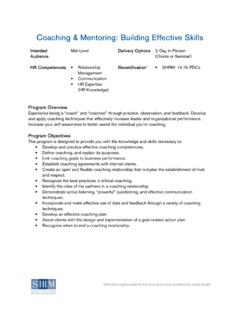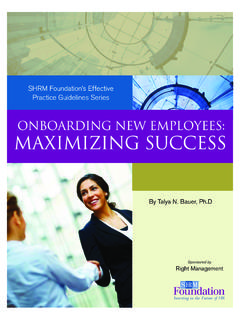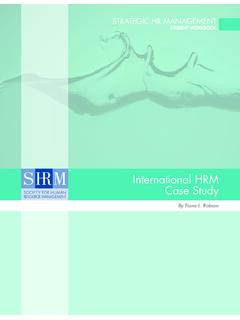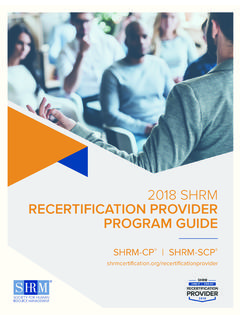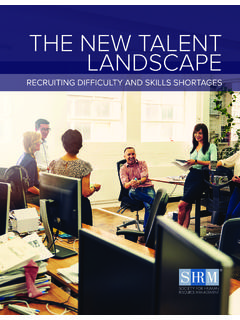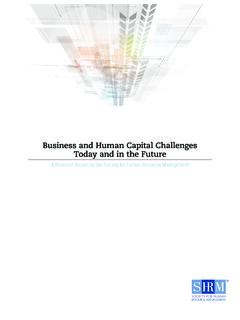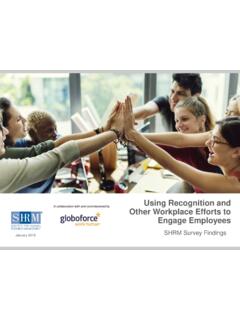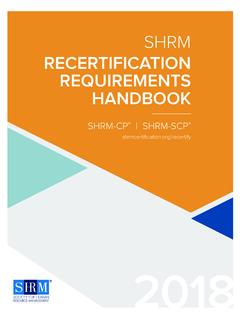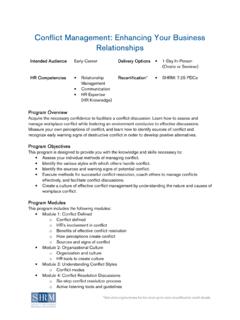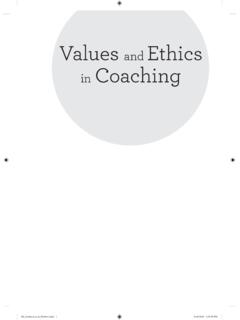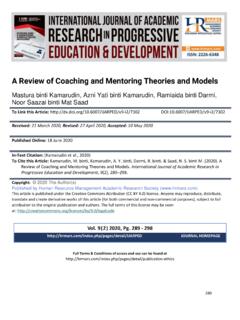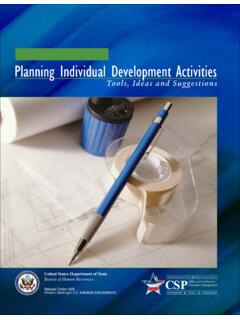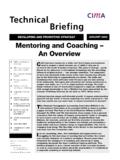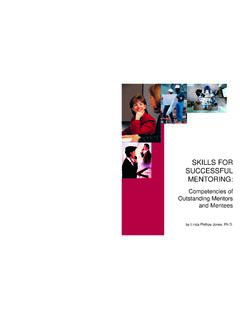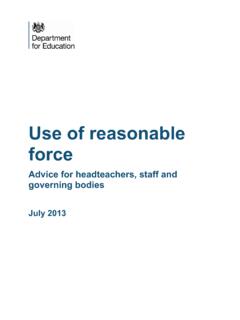Transcription of Coaching for Professional Development - SHRM
1 Coaching for Professional Development Joel DiGirolamo Director of Coaching Science International Coach Federation (ICF) 859-219-3553 Copyright 2015 Society for Human Resource Management and Society for Industrial and Organizational Psychology The views expressed here are those of the authors and do not necessarily reflect the view of any agency of the government nor are they to be construed as legal advice. SHRM-SIOP Science of HR White Paper Series 2 Joel DiGirolamo is the director of Coaching science for the International Coach Federation (ICF), where he leads the organization s efforts to develop, curate and disseminate information around the science of Coaching . He has more than 30 years of staff and management experience in Fortune 500 companies and is the author of two books, Leading Team Alpha and Yoga in No Time at All.
2 Joel holds a master s degree in industrial and organizational psychology from Kansas State University, an MBA from Xavier University and a bachelor s degree in electrical engineering from Purdue University. He is a member of the Society for Industrial and Organizational Psychology (SIOP), the Society of Consulting Psychology (SCP), the American Psychological Association (APA) and the Society for Human Resource Management (SHRM). 3 What Is Coaching ? Coaching is a unique endeavor. Coaches partner with clients in a transformative process that empowers and inspires them to reach their maximum potential. The Coaching process is about moving forward, working with the client to stretch and reach goals he or she desires.
3 Figure 1 illustrates this concept. The coach provides a stable reference while supporting the client in his or her journey from place or attitude A to B. Fundamentally, it is about facilitating a change or transformation within the client. Coaching is frequently used to assist individuals as they prepare for or move into new assignments, improve work habits, adapt to a changing environment or overcome specific obstacles. ABSTRACT Coaching can be an effective and integral component of leadership Development programs. Popular among human resource professionals and clients, Coaching facilitates leaders Professional growth and helps to build a powerful team from executives to first-line managers and team leaders.
4 Coaching has a proven track record of success, and many studies have shown how Coaching enhances decision-making skills, improves interpersonal effectiveness and increases confidence. The maturing workforce necessitates thoughtful succession planning, and Coaching is often a strategic element of this effort. Integrating Coaching into an organization s culture will ensure the longevity and sustained value of the program. Figure 1. Client Journey 4 Coaching is often confused with other personal or organizational support modalities, such as mentoring , consulting and psychotherapy. In a mentoring relationship, an expert provides advice and counsel based on his or her wisdom or experience.
5 A consultant gives advice (usually of a business or technical nature), diagnoses problems and designs solutions. Psychotherapy involves healing pain, dysfunction and conflict, often with a focus on resolving past difficulties or healing old wounds. Making the Case for Coaching Academic research and organizational evaluations have demonstrated the effectiveness of Professional Coaching . A meta-analysis of 18 quantitative studies of organizational Coaching showed that Coaching has a significant effect on performance, skills, well-being, coping, attitudes and self-regulation (Theeboom, Beersma, & van Vianen, 2013). Meanwhile, managers and leaders at organizations where Coaching is used have reported a host of positive effects, including improved team functioning, increased engagement, improved employee relation and increased commitment (Human Capital Institute & International Coach Federation, 2014).
6 Decisions on how to measure Coaching effectiveness are sometimes contentious and often difficult. Return on investment (ROI) calculations are sometimes used to achieve a hard number illustrating money saved through measures such as increased productivity and reduced turnover. In a 2009 global study commissioned by the International Coach Federation (ICF), of 2,165 respondents 40% indicated that their 5 organization had experienced financial changes as a result of Coaching . Based upon a sample of respondents who provided detailed results, it is likely that more than half of these changes were positive (International Coach Federation, 2009). Usually, 360-degree surveys administered before Coaching begins and again several months after the Coaching engagement ends provide a clear picture of the progress made.
7 These assessments, however, can be tedious to arrange and expensive to administer. Measuring the nonmonetary benefits of Coaching is even more difficult. Many organizations use return on expectations (ROE) measurements to quantify these benefits. An organization might measure ROE by assessing changes in clients self-reported ability to achieve their goals. Examples of goals might include increasing self-confidence, improving interpersonal relationships or enhancing work performance. Some organizations prefer even simpler measures, such as asking clients if they felt the Coaching was worth their time, whether it made a positive change and if they would recommend it to a colleague. Depending on the need, such simple measures may be sufficient justification to continue a Coaching program.
8 The Coaching process is about moving forward, working with the client to stretch and reach goals he or she desires. 6 Elements of Coaching Coaching is generally considered a recent phenomenon in the business realm; however, as Figure 2 illustrates, it can trace its roots to many fields, including the Human Potential Movement (HPM) of the 1960s, philosophy, business and humanistic psychology, among other traditions (Stein, 2003; Brock, 2008). The HPM and associated Large Group Awareness Training (LGAT) programs attempt to enhance individual self-awareness, facilitate growth and inspire individuals to seek their full potential (Finkelstein, Wenegrat, & Yalom, 1982). The HPM and, subsequently, Coaching were influenced by humanistic psychology pioneers, including Carl Rogers and Abraham Maslow (DeCarvalho, 1991; Brock, 2008) and influential business writers such as Dale Carnegie and Napoleon Hill (Brock, 2008).
9 Carl Rogers was one of the founders of the field of humanistic psychology. He emphasized the need to focus on and maintain a presence with the client (Rogers, 1957). Albert Bandura, a social psychologist, provided a significant contribution to Figure 2. Influences on Coaching 7 Coaching with his theory that behavioral change may be a result of conscious, or cognitive, thought rather than an immediate reaction to present circumstances (Bandura, 1982). The self-motivation to change and develop a life that fulfills and brings happiness to the individual was theorized by Abraham Maslow (Maslow, 1943) and heavily influenced the HPM (Brock, 2008). More recently, the field of positive psychology has moved away from the focus on mentally unhealthy behaviors to mentally healthy behaviors.
10 This field, promoted by Martin Seligman and others, concentrates on happiness and how to flourish in life, bringing greater satisfaction to individuals in all aspects of their lives (Seligman & Cs kszentmih lyi, 2000). Self-improvement professionals Dale Carnegie and Napoleon Hill promoted behavioral changes in order to achieve success in both business and personal aspects of life (Carnegie, 1936; Hill, 1937). The essence of the books and programs by Carnegie and Hill that one can be successful by envisioning and persisting toward goals was adopted by the HPM and Coaching in general (Brock, 2008). Philosophy has also played a role in the Development of Coaching . Eastern philosophy promotes the need to look at the big picture and search for balance and harmony; Western philosophy seeks to understand contradictions, reality and ways to master it (Brock, 2008).
